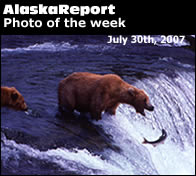
 |
 |
Russia plants flag under North Pole to claim territoryAugust 3, 2007Moscow, Russia - Russia dispatched two submarines to plant their country's flag on the seabed below the North Pole in a bid to further Moscow's claims to the Arctic. 
The rust-proof titanium metal flag was brought by explorers travelling in two mini-submarines, in what is believed to be the first expedition of its kind. Both vessels have now rejoined the expedition's ships, completing their risky return journey to the surface. Canada, which also claims territory in the Arctic, has criticised the mission. "This isn't the 15th Century," Canadian Foreign Minister Peter MacKay told the CTV channel. "You can't go around the world and just plant flags and say 'We're claiming this territory'," he said. Melting polar ice has led to competing claims over access to Arctic resources. Russia's claim to a vast swathe of territory in the Arctic, thought to contain oil, gas and mineral reserves, has been challenged by several other powers, including the US. 'Heroic mission' The Russian mission's leader, explorer and parliamentarian Artur Chilingarov, said the flag would be a permanent mark of Russia's presence at the pole. "If a hundred or a thousand years from now someone goes down to where we were, they will see the Russian flag," the Itar-Tass news agency quoted him as saying. "It was so lovely down there," he said. He earlier told Itar-Tass that his mini-submarine had a "smooth" landing on the seabed. "The yellowish ground is around us, no sea dwellers are seen," he said. The mini-submarines, Mir-I and Mir-II, were brought to the North Pole by the two ships in the Russian expedition - a nuclear-powered ice-breaker and a research vessel. The expedition set off last week from the port of Murmansk in search of geological evidence to back up Moscow's claims to the resource-rich Arctic seabed. Scientists aboard the submarines had also planned to collect samples of Arctic flora and fauna. Russian media reported last week that the ships were briefly tailed by foreign aircraft, but this claim was played down by the expedition leader. The submarines' return from the seabed to the surface was regarded as the most dangerous part of the journey. The vessels risked being trapped beneath the Arctic ice sheet unless they could navigate back to the exact gap in the ice where they set off from. "This may sound grandiloquent but for me this is like placing a flag on the moon, this is really a massive scientific achievement," Sergei Balyasnikov, a spokesman for Russia's Arctic and Antarctic Institute, told Reuters news agency. Competing claims President Vladimir Putin has already described the urgent need for Russia to secure its "strategic, economic, scientific and defence interests" in the Arctic. Moscow argued before a UN commission in 2001 that waters off its northern coast were in fact an extension of its maritime territory. The claim was based on the argument that an underwater feature, known as the Lomonosov Ridge, was an extension of its continental territory, but it was rejected and Russia told to resubmit with more evidence. Several countries with territories bordering the Arctic - including Russia, the US, Canada and Denmark - have launched competing claims to the region. The competition has intensified as melting polar ice caps have opened up the possibility of new shipping routes in the region. Current laws grant countries an economic zone of 200 nautical miles beyond their land borders. This zone can be extended where a country can prove that the structure of the continental shelf is similar to the geological structure within its territory. The North Pole is not currently regarded as part of any single country's territory and is therefore administered by the International Seabed Authority. © AlaskaReport News |
Alaska Cruises starting at $499 |